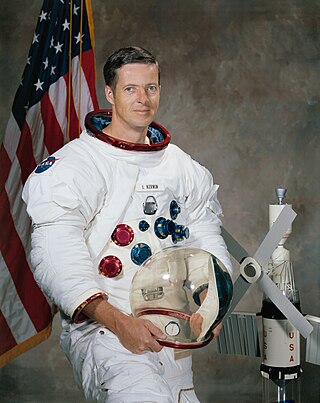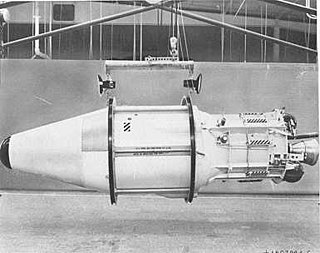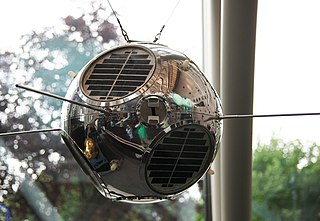
Space exploration is the use of astronomy and space technology to explore outer space. While the exploration of space is carried out mainly by astronomers with telescopes, its physical exploration is conducted both by uncrewed robotic space probes and human spaceflight. Space exploration, like its classical form astronomy, is one of the main sources for space science.

Skylab was the first United States space station, launched by NASA, occupied for about 24 weeks between May 1973 and February 1974. It was operated by three separate three-astronaut crews: Skylab 2, Skylab 3, and Skylab 4. Major operations included an orbital workshop, a solar observatory, Earth observation, and hundreds of experiments.

The Corona program was a series of American strategic reconnaissance satellites produced and operated by the Central Intelligence Agency (CIA) Directorate of Science & Technology with substantial assistance from the U.S. Air Force. The CORONA satellites were used for photographic surveillance of the Soviet Union (USSR), China, and other areas beginning in June 1959 and ending in May 1972.

John Howard Casper is a former American astronaut and retired United States Air Force pilot.

Robert Laurel Crippen is an American retired naval officer and aviator, test pilot, aerospace engineer, and retired astronaut. He traveled into space four times: as pilot of STS-1 in April 1981, the first Space Shuttle mission; and as commander of STS-7 in June 1983, STS-41-C in April 1984, and STS-41-G in October 1984. He was also a part of the Manned Orbiting Laboratory (MOL), Skylab Medical Experiment Altitude Test (SMEAT), ASTP support crew member, and the Approach and Landing Tests (ALT) for the Space Shuttle.

The Columbia Accident Investigation Board (CAIB) was an internal commission convened by NASA to investigate the destruction of the Space Shuttle Columbia during STS-107 upon atmospheric re-entry on February 1, 2003. The panel determined that the accident was caused by foam insulation breaking off from the external fuel tank, forming debris which damaged the orbiter's wing, and that the problem of "debris shedding" was well known but considered "acceptable" by management. The panel also recommended changes that should be made to increase the safety of future shuttle flights. The CAIB released its final report on August 26, 2003.

STS-76 was NASA's 76th Space Shuttle mission, and the 16th mission for Atlantis. STS-76 launched on 22 March 1996 at 08:13:04 UTC from Kennedy Space Center, launch pad 39B. STS-76 lasted over 9 days, traveled about 6,100,000 km (3,800,000 mi) while orbiting Earth an estimated 145 times, and landing at 13:28:57 UTC on 31 March 1996 at Edwards Air Force Base, runway 22.

David Mathieson "Dave" Walker, , was an American naval officer and aviator, fighter pilot, test pilot, and a former NASA astronaut. He flew aboard four Space Shuttle missions in the 1980s and 1990s.

Edward George Gibson is a former NASA astronaut, pilot, engineer, and physicist.

Joseph Peter Kerwin is an American physician and former NASA astronaut, who served as Science Pilot for the Skylab 2 mission from May 25 – June 22, 1973. He was the first physician to be selected for astronaut training. Joe Kerwin was the one who uttered the words during Apollo 13: “Farewell, Aquarius, and we thank you.” Kerwin was inducted into the United States Astronaut Hall of Fame in 1997.

The Manned Orbiting Laboratory (MOL) was part of the United States Air Force (USAF) human spaceflight program in the 1960s. The project was developed from early USAF concepts of crewed space stations as reconnaissance satellites, and was a successor to the canceled Boeing X-20 Dyna-Soar military reconnaissance space plane. Plans for the MOL evolved into a single-use laboratory, for which crews would be launched on 30-day missions, and return to Earth using a Gemini B spacecraft derived from NASA's Gemini spacecraft and launched with the laboratory.

Skylab 4 was the third crewed Skylab mission and placed the third and final crew aboard the first American space station.

NASA Astronaut Group 4 was a group of six astronauts selected by NASA in June 1965. While the astronauts of the first two groups were required to have an undergraduate degree or the professional equivalent in engineering or the sciences, they were chosen for their experience as test pilots. Test pilot experience was waived as a requirement for the third group, and military jet fighter aircraft experience could be substituted. Group 4 was the first chosen on the basis of research and academic experience, with NASA providing pilot training as necessary. Initial screening of applicants was conducted by the National Academy of Sciences.
Criticism of the Space Shuttle program stemmed from claims that NASA's Space Shuttle program failed to achieve its promised cost and utility goals, as well as design, cost, management, and safety issues. Fundamentally, it failed in the goal of reducing the cost of space access. Space Shuttle incremental per-pound launch costs ultimately turned out to be considerably higher than those of expendable launchers. By 2011, the incremental cost per flight of the Space Shuttle was estimated at $450 million, or $18,000 per kilogram to low Earth orbit (LEO). In contrast, the comparable Proton launch vehicle is said to cost as little as $110 million, or around $5,000 per kilogram to LEO, despite not being reusable.

Thor-Agena was a series of orbital launch vehicles. The launch vehicles used the Douglas-built Thor first stage and the Lockheed-built Agena second stages. They are thus cousins of the more-famous Thor-Deltas, which founded the Delta rocket family. The first attempted launch of a Thor-Agena was in January 1959. The first successful launch was on 28 February 1959, launching Discoverer 1. It was the first two-stage launch vehicle to place a satellite into orbit.

Discoverer 1 was the first of a series of satellites which were part of the CORONA reconnaissance satellite program. It was launched on a Thor-Agena A rocket on 28 February 1959 at 21:49:16 GMT from Vandenberg Air Force Base in California. It was a prototype of the KH-1 satellite, but did not contain either a camera or a film capsule. It was the first satellite launched toward the South Pole in an attempt to achieve a polar orbit, but was unsuccessful. A CIA report, later declassified, concluded that "Today, most people believe the Discoverer 1 landed somewhere near the South Pole".

The National Aeronautics and Space Administration is an independent agency of the U.S. federal government responsible for the civil space program, aeronautics research, and space research.

SOLRAD 4B was a solar X-ray, ultraviolet, and electronic surveillance satellite. Developed by the United States Navy's United States Naval Research Laboratory, it was the fifth in both the SOLRAD and the GRAB programs.
It is inevitable that medical conditions of varying complexity, severity and emergency will occur during spaceflight missions with human participants. Different levels of care are required depending on the problem, available resources and time required to return to Earth.
















